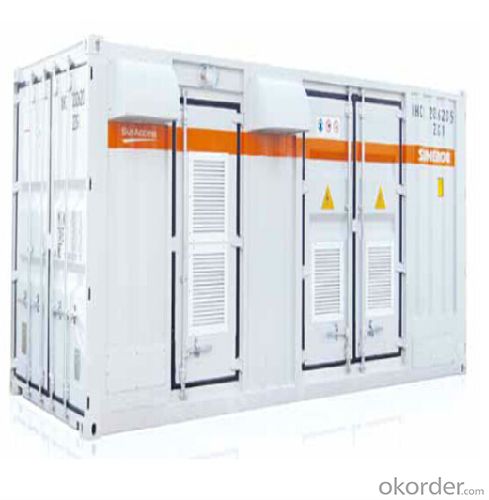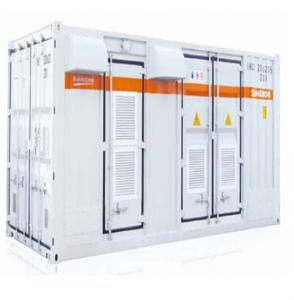Photovoltaic Grid-Connected Inverter SG1000TS-MV
- Loading Port:
- China Main Port
- Payment Terms:
- TT or LC
- Min Order Qty:
- 50 unit
- Supply Capability:
- 1000 unit/month
OKorder Service Pledge
OKorder Financial Service
You Might Also Like
1. Structure of Photovoltaic Grid-Connected Inverter SG1000TS-MV Description
A solar inverter, or PV inverter, or Solar converter, converts the variable direct current (DC) output of a photovoltaic (PV) solar panel into
autility frequency alternating current (AC) that can be fed into a commercial electrical grid or used by a local, off-grid electrical network.
It is acritical BOS–component in a photovoltaic system, allowing the use of ordinary AC-powered equipment. Solar inverters have
special functions adapted for use with photovoltaic arrays, including maximum power point tracking and anti-islanding protection.
Suitable for 50Hz/60Hz grid, could be used in Asia, North America and Europe.
2. Main Features of the Photovoltaic Grid-Connected Inverter SG1000TS-MV
• Turn-key solution,high integration
• Integrated PV inverter, DC/AC power distribution, medium-voltage transformer, system monitoring, fire alarm, environment monitoring functional modules and so on
• Save AC cables, lower consumption and promote users’ benefits
• SCADA monitoring system integrated to reduce the costs and ensure the optimal status of the plant
* Easy for Transportation and Handling, Environment Adaptable
• Container design, easy for transportation
• Integral hoisting, easy to install, reduce the installation cost and risks.
• Standard container enclose, integrated design for ventilation, sandproof, anti-corrosion and anti-low-temperature and other application requirements.
* Advanced Technology, Grid-friendly
• Efficiency, energy-saving and reliability as with all Sungrow inverters
• Integrated with standard power dispatch interfaces, convenient and flexible access to power grid;
• LVRT (Zero-voltage Ride-through), Reactive power control with power factor from 0.9 lagging to 0.9 leading, Give reactive power compensation to the grid at night according to directive
3. Photovoltaic Grid-Connected Inverter SG1000TS-MV Images


4. Photovoltaic Grid-Connected Inverter SG1000TS-MV Specification
Side Data | |
Max. DC power (@ cos φ =1) | 1120kW |
Max. input voltage | 1000V |
Start voltage | 500V |
Min. working voltage | 460V |
Max. input current | 2440A |
MPPT voltage range | 460~850V |
Number of DC inputs | 16/32 |
Output Side Data | |
Rated power | 1000kW |
Max. output AC power | 1100kVA |
Max. output current | 63.5A |
Max. THD | <3%(at nominal power) |
Rated grid voltage | 10-24kV |
Rated grid frequency | 50Hz / 60Hz |
Grid frequency range | 47~52Hz / 57 ~62Hz |
Power factor at rated power | >0.99 |
DC current injection | <0.5% of rated inverter output current |
Adjustable displacement factor | 0.9 (lagging) ~0.9 (leading) |
Efficiency | |
Max. efficiency | 98.00% |
European efficiency | 97.50% |
Protection | |
DC input side disconnection device | Switch-disconnector with fuses |
AC output side disconnection device | Switch-disconnector with fuses |
DC overvoltage protection | Yes |
AC overvoltage protection on the LV side | Yes |
Grid monitoring | Yes |
Ground fault monitoring | Yes |
Overheat protection | Yes |
Insulation monitoring | Yes |
General Data | |
Dimensions(W×H×D) | 6058x2591x2438mm |
Weight | 12T |
Operating temperature range | -35~50℃ |
External auxiliary supply voltage (Opt.) | 380V |
Cooling concept | Temperature controlled air-cooling |
Degree of protection | IP54 |
Max. permissible value for relative humidity (non-condensing) | 0~95%, non -condensing |
Max. altitude | 6000m (derating > 3000m) |
Communication port/protocols | Standard: RS485/ Modbus, Internet |
Options: CDT, DNP3.0, 101, 103, 104, GPRS/CDMA module | |
5. FAQ of Photovoltaic Grid-Connected Inverter SG1000TS-MV
Q1. What is the difference between inverter and solar inverter?
A1. Inverter only has AC inpput, but solar inverter both connect to AC input and solar panel, it saves more power.
Q2. What is the difference between MPPT&PWM?
A2. MPPT has higher efficiency, it can track the max power point and won't waste energy.
- Q:Can a solar inverter be used with a net metering system?
- Yes, a solar inverter can be used with a net metering system. In fact, a solar inverter is an essential component of a net metering system. It converts the direct current (DC) electricity generated by the solar panels into alternating current (AC) electricity that can be used to power the home or business. The excess electricity produced by the solar panels is fed back into the grid through the net meter, allowing the utility company to credit the owner for the excess energy produced.
- Q:How does the weight of a solar inverter affect its installation process?
- The weight of a solar inverter can affect its installation process in a few ways. Firstly, a heavier inverter may require additional structural support or mounting equipment to ensure it is securely installed. This could involve reinforcing the mounting surface or using specialized brackets or racks. Secondly, the weight of the inverter may impact the ease of handling and maneuvering during installation, especially if it needs to be installed in elevated or hard-to-reach areas. Lastly, the weight can also impact the overall logistics of the installation, including transportation, lifting, and positioning of the inverter.
- Q:Can a solar inverter be used in a mobile or portable solar power system?
- Yes, a solar inverter can be used in a mobile or portable solar power system. The inverter converts the direct current (DC) generated by the solar panels into alternating current (AC), which is required to power most electronic devices. By incorporating a solar inverter, the mobile or portable solar power system can provide AC power for various applications, such as charging electronic devices or running small appliances, making it a versatile and convenient solution for powering devices on the go.
- Q:How do you choose the right voltage rating for a solar inverter?
- When choosing the right voltage rating for a solar inverter, it is important to consider a few factors. First, you need to determine the voltage of your solar panel array. This will help you match the inverter's voltage rating to ensure compatibility. Additionally, you should consider the voltage requirements of your electrical grid or any appliances you plan to power. The inverter's voltage rating should align with these requirements to ensure efficient energy conversion and safe operation. It is advisable to consult with a professional or an electrical engineer to help you select the appropriate voltage rating for your solar inverter based on your specific needs and system setup.
- Q:Can a solar inverter be used in a net metering system?
- Yes, a solar inverter can be used in a net metering system. A solar inverter is an essential component of a solar energy system, as it converts the direct current (DC) electricity generated by solar panels into alternating current (AC) electricity that can be used to power homes and businesses. In a net metering system, excess electricity generated by the solar panels is fed back into the grid, and a solar inverter facilitates this process by synchronizing the electricity produced with the utility grid.
- Q:Are there any electromagnetic interference concerns associated with solar inverters?
- Yes, there can be electromagnetic interference concerns associated with solar inverters. These concerns mainly arise from the high-frequency switching of power electronics within the inverters. However, modern solar inverters are designed to minimize electromagnetic interference through the use of appropriate filters and shielding techniques. Compliance with relevant electromagnetic compatibility (EMC) standards ensures that solar inverters do not interfere with other electronic devices and are safe to use in residential and commercial settings.
- Q:What is the role of a solar inverter in a microgrid system?
- The role of a solar inverter in a microgrid system is to convert the direct current (DC) electricity generated by solar panels into alternating current (AC) electricity that can be used to power the various loads within the microgrid. It also manages the flow of electricity between the microgrid and the utility grid, allowing for bidirectional power flow and enabling the system to operate in both grid-connected and islanded modes. Additionally, the solar inverter ensures the stability and quality of the electricity supply, regulating voltage and frequency levels to match the requirements of the microgrid.
- Q:What is the maximum number of solar panels that can be connected to a single inverter?
- The maximum number of solar panels that can be connected to a single inverter depends on the capacity of the inverter and the power output of each individual solar panel. It is recommended to consult the manufacturer's specifications for the specific inverter being used to determine the maximum number of panels that can be connected.
- Q:Are there any fire safety concerns associated with solar inverters?
- Yes, there are some fire safety concerns associated with solar inverters. While solar inverters are generally safe and undergo rigorous testing to meet safety standards, there have been rare instances of fires caused by faulty inverters or improper installation. It is crucial to ensure that inverters are installed by qualified professionals following manufacturer guidelines and regularly inspected for any signs of damage or malfunction. Additionally, proper maintenance and monitoring of the inverter system can help mitigate any potential fire risks.
- Q:Does a solar inverter require any additional cooling or ventilation?
- Yes, a solar inverter typically requires additional cooling or ventilation to maintain its optimal operating temperature and prevent overheating. This is because solar inverters convert DC power from solar panels into AC power, a process that generates heat. Adequate cooling or ventilation systems help dissipate this heat and ensure the inverter operates efficiently and reliably.
1. Manufacturer Overview |
|
|---|---|
| Location | |
| Year Established | |
| Annual Output Value | |
| Main Markets | |
| Company Certifications | |
2. Manufacturer Certificates |
|
|---|---|
| a) Certification Name | |
| Range | |
| Reference | |
| Validity Period | |
3. Manufacturer Capability |
|
|---|---|
| a)Trade Capacity | |
| Nearest Port | |
| Export Percentage | |
| No.of Employees in Trade Department | |
| Language Spoken: | |
| b)Factory Information | |
| Factory Size: | |
| No. of Production Lines | |
| Contract Manufacturing | |
| Product Price Range | |
Send your message to us
Photovoltaic Grid-Connected Inverter SG1000TS-MV
- Loading Port:
- China Main Port
- Payment Terms:
- TT or LC
- Min Order Qty:
- 50 unit
- Supply Capability:
- 1000 unit/month
OKorder Service Pledge
OKorder Financial Service
Similar products
New products
Hot products
Hot Searches
Related keywords





























